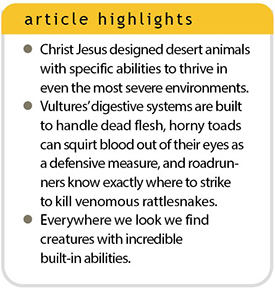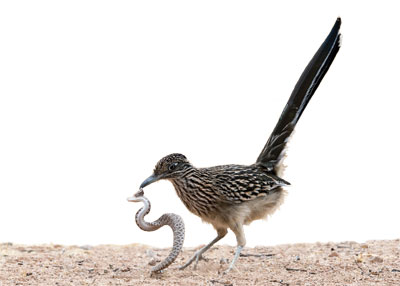 Grand Canyon animals display many marvelous traits and behaviors as they live life in that harsh habitat. These canyon creatures succeed thanks to the Lord Jesus Christ’s providential provisioning and not due to impersonal “luck.”
Grand Canyon animals display many marvelous traits and behaviors as they live life in that harsh habitat. These canyon creatures succeed thanks to the Lord Jesus Christ’s providential provisioning and not due to impersonal “luck.”
Turkey Vultures
It’s not by good luck that turkey vultures can find rotten carrion, gobble it down, and not die of food poisoning. Vultures have powerful senses of sight and smell; they detect dead animals from afar. Equipped by God for scavenging in this fallen world, they serve as garbage collectors/processors, picking apart and eating roadkill and other carcasses.
Why don’t they get sick or die of botulism? The acidity of vultures’ digestive tracts is astounding. The digestive juices in their stomachs can reach a pH between 1.5 and 1.0, more corrosive than car battery acid and caustic enough to instantly denature to death almost any bacterial or viral pathogen!1 If the vultures’ Creator had not constructed their stomachs with such germ-destroying acidity, the vultures themselves would quickly become dead meat.
Horned Lizards
If these lizards’ camouflage fails to defend them against predators, they can flee. But there’s more—many horned lizards (aka “horny toads”) can aim and squirt a stream of blood from the corners of their eyes! By constraining blood flow to build up blood pressure, blood vessels near the lizards’ eyelids rupture, producing a target-directed squirt of blood. Felines (such as bobcats or cougars) and canines (such as coyotes or foxes) hate the taste of lizard eye blood.2
Of course, it’s not by evolutionary accident that horned lizards have this ability to squirt blood up to five feet from their eyes to repel approaching predators. This bizarre defense—called ocular-sinus blood-squirting—is not something that lizards luckily evolved “as needed” by trial-and-error as hungry predators lunged at them in the canyon!
Roadrunners

Likewise, roadrunners did not luckily learn by hit-or-miss guessing how to speedily bite a rattlesnake next to its venomous fangs to prevent a striking rattler from successfully biting them.
Amazingly, God has designed the roadrunner so it can speedily aim at the face and fangs of a striking rattler, using its pointed bill to bite and clamp onto the rattler’s open mouth between or behind the upper fangs, lock-biting the snake in a death grip. Then the bird repeatedly thrashes and crushes the serpent’s head against rocks, killing it.3
Rabbits, Wasps, Squirrels, and Rats
As noted in previous Acts & Facts articles, other canyon critters exhibit Christ’s creative and caring providences, such as black-tailed jackrabbits (whose huge ears radiate excess body heat),3 tarantula hawk wasps (who inject their young into the flesh of tarantula spiders),4 tassel-eared squirrels (who mutualistically help their neighborhood’s ponderosa pine and truffle fungi),4 kangaroo rats (who don’t need to drink water due to their water-conserving physiology),3 and more.
Grand Canyon’s diverse denizens continuously track environmental conditions and then self-adjust their traits and behaviors for purposeful results.5 Canyon critters survive because of precisely targeted solutions to habitat challenges.
Truly, Grand Canyon houses a community of amazing animals. Those animals display Christ’s bioengineering genius in design details and demonstrate the Creator’s providential provision for wildlife living in Grand Canyon.
References
- Chen, Y. et al. 2023. Vultures as a Model for Testing Molecular Adaptations of Dietary Specialization in Birds. Avian Research. 14: 100128; Buechley, E. R. and C. H. Sekercioglu. 2016. Vultures. Current Biology. 26 (13): R560–R561. Genesis 15:11 reports on carrion-seeking birds whose behavior resembles that of vultures.
- Sherbrooke, W. C. and G. A. Middendorf III. 2001. Blood-Squirting Variability in Horned Lizards (Phrynosoma). Copeia. 2001 (4): 1114–1122; Blood Squirting Lizard. National Geographic. YouTube video. Posted on youtube.com October 15, 2010. Interestingly, ICR Director of Communications Jayme Durant was squirted by one of these lizards when she was a child. She said, “I used to carry them around, and I must’ve scared that one a little bit when I was talking to it face to face as if it were a beloved pet. He responded by covering my face with blood!”
- Johnson, J. J. S. 2017. Rats, Rabbits, and Roadrunners: Fitted to Fill. Acts & Facts. 46 (7): 21.
- Johnson, J. J. S. 2018. Grand Canyon Neighbors: Pines, Truffles, and Squirrels. Acts & Facts. 47 (10): 21; Johnson, J. J. S. 2011. Slow Death for a Tarantula: A Lesson in Arachnid Apologetics. Acts & Facts. 40 (10): 10–11.
- Guliuzza, R. J. and P. Gaskin. 2018. Continuous Environmental Tracking: An Engineering Framework to Understand Adaptation and Diversification. Proceedings of the International Conference on Creationism. 8: 158–184, article 11. See also Job 9:10 (“wonders without number”).
* Dr. Johnson is associate professor of apologetics and chief academic officer at the Institute for Creation Research.













